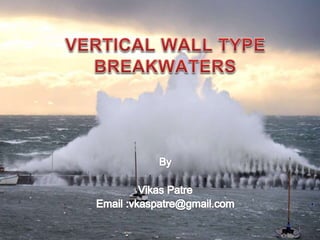
Vertical wall type breakwaters
- 1. 1
- 2. A wall or upright or vertical faced breakwater is defined as a big regular wall raised to construct a harbor basin on solid natural or/and artificial foundation to resist the forces and their components generated by incoming water and waves. 2
- 3. FUNCTIONS • Wave protection in port, • Protection from siltation, currents • Tsunami protection • Berthing facilities • Access/transport facility Vertical Wall Breakwaters - Functions The original concept of the vertical breakwater was to reflect waves, while that for the rubble-mound breakwater was to break them. 3
- 4. BREAKWATER LAYOUT- Ideally, breakwaters are placed so as to provide an area that is sufficiently large and protected from wave action so that it is adequate for safe entering and maneuvering of the largest design vessels and adequate functioning of the port. 4
- 5. 1. Caisson breakwaters 2. Block type 3. Piled breakwater with concrete wall 4. Perforated front wall 5. Semi-circular caisson 6. Dual cylindrical caisson 5
- 6. Caisson breakwaters typically have vertical sides and are usually erected where it is desirable to berth one or more vessels on the inner face of the breakwater. They use the mass of the caisson and the fill within it to resist the overturning forces applied by waves hitting them. They are relatively expensive to construct in shallow water, but in deeper sites they can offer a significant saving over mound type breakwaters. The caisson is placed on a high rubble foundation. 6
- 7. 7
- 8. The front slope of the caisson is covered by armour units This type is used in shallow water. The mound reduces wave reflection, wave impact and wave overtopping Gela (Sicily, Italy) 8
- 9. This type of breakwater needs to be placed on rock sea beds or on very strong soils due to very high foundation loads and sensitivity to differential settlements 9
- 10. Piled breakwaters consist of an inclined or curtain wall mounted on pile work. The type is applicable in less severe wave climates on site with weak and soft subsoils with very thick layers. Manfredonia New Port (Italy) 10
- 11. The upper part of the front slope above still water level is given a slope to reduce wave forces and improve the direction of the wave forces on the sloping front. Overtopping is larger than for a vertical wall with equal level. 11
- 12. The front wall is perforated by holes or slots with a wave chamber behind. Due to the dissipation of energy both the wave forces on the caisson and the wave reflection are reduced Dieppe (France) 12
- 13. Well suited for shallow water situations with intensive wave breaking Due to the dissipation of energy both the wave forces on the caisson and the wave reflection are reduced Miyazaki Port (Japan) 13
- 14. Outer permeable and inner impermeable cylinder. Low reflection and low permeable Centre chamber and lower ring chamber filles with sand Nagashima Port (Japan) 14
- 15. Loads and resistance: • Hydraulic loads • Weight Resistance: Friction (mostly) Soil bearing capacity HL W F R 15
- 16. Failure modes (overall) Hydraulic failure Geotechnical failure Sliding Overturning Slip W FH W FH W Planar slip 16
- 17. Failure modes (local) Instability of mound Erosion of seabed Partial Instability U Scour 17
- 18. Advantages 1. Provide a larger harbor area and narrower entrance 2. Reduce the amount of material. 3. Avoid dangers of unequal settlement 4. Maintenance costs are nearly eliminated' 5. Where rock unavailable, may save time and money Disadvantages 1. Can be constructed only where foundation conditions are favorable 2. Not flexible~ e.g.~ in adjusting to settlement and disturbance 3. Difficult to repair if damaged 4. Construction requires more extensive and heavier equipment 18
- 19. References- HARBOUR DOCK ENGINEERING :by R.Srinivasan PORT ENGINEERING: by Gregory P. Tsinker http://www.bscw.ihe.nl/ http://www.wikipedia.org/ 19
- 20. 20
